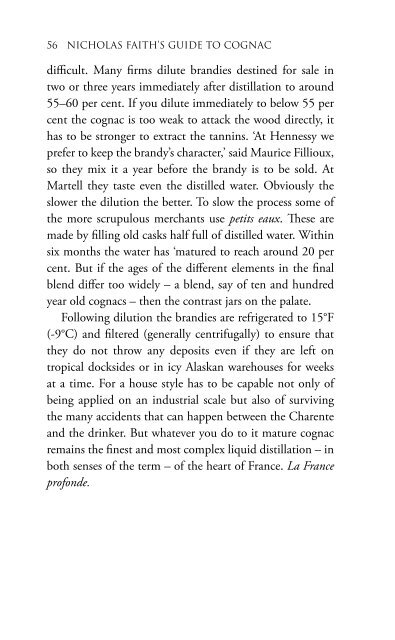Create successful ePaper yourself
Turn your PDF publications into a flip-book with our unique Google optimized e-Paper software.
difficult. Many firms dilute brandies destined for sale in<br />
two or three years immediately after distillation to around<br />
55–60 per cent. If you dilute immediately to below 55 per<br />
cent the cognac is too weak to attack the wood directly, it<br />
has to be stronger to extract the tannins. ‘At Hennessy we<br />
prefer to keep the brandy’s character,’ said Maurice Fillioux,<br />
so they mix it a year before the brandy is to be sold. At<br />
Martell they taste even the distilled water. Obviously the<br />
slower the dilution the better. To slow the process some of<br />
the more scrupulous merchants use petits eaux. These are<br />
made by filling old casks half full of distilled water. Within<br />
six months the water has ‘matured to reach around 20 per<br />
cent. But if the ages of the different elements in the final<br />
blend differ too widely – a blend, say of ten and hundred<br />
year old cognacs – then the contrast jars on the palate.<br />
Following dilution the brandies are refrigerated to 15°F<br />
(-9°C) and filtered (generally centrifugally) to ensure that<br />
they do not throw any deposits even if they are left on<br />
tropical docksides or in icy Alaskan warehouses for weeks<br />
at a time. For a house style has to be capable not only of<br />
being applied on an industrial scale but also of surviving<br />
the many accidents that can happen between the Charente<br />
and the drinker. But whatever you do to it mature cognac<br />
remains the finest and most complex liquid distillation – in<br />
both senses of the term – of the heart of France. La France<br />
profonde.<br />
3<br />
THE PRODUCERS AND<br />
THEIR BRANDIES<br />
This <strong>directory</strong> – which will be regularly updated in future – is<br />
the fruit of thirty years’ experience in writing about cognac,<br />
visiting the region’s producers and discussing their offerings<br />
with them. The tasting notes reflect my personal tastes, which<br />
are for cognacs which combine purity – that is, the lack of<br />
any apparent sugar, caramel, or artificial woodiness – with<br />
positive qualities, reflecting grapiness, nuttiness and fresh or<br />
candied fruitiness. After twenty or more years in wood the<br />
best cognacs acquire the unique quality of rancio, a rich blend<br />
involving nuts of all descriptions as well as candied fruits,<br />
similar to that of the rich fruit cakes beloved of the English.<br />
<strong>Cognac</strong>s over the age of six (a figure which will increase<br />
to ten in 2016) can legally be called any name of the<br />
producer’s choosing so, quality-wise, these names are<br />
pretty meaningless. A few will be of single vintages, but<br />
only the handful which are claimed as being before 1988,


